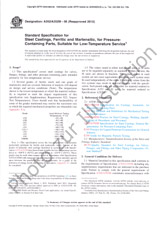Wir benötigen Ihre Einwilligung zur Verwendung der einzelnen Daten, damit Sie unter anderem Informationen zu Ihren Interessen einsehen können. Klicken Sie auf "OK", um Ihre Zustimmung zu erteilen.
ASTM D7048-16
Standard Guide for Applying Statistical Methods for Assessment and Corrective Action Environmental Monitoring Programs (Withdrawn 2025)
Name übersetzen
NORM herausgegeben am 1.10.2016
Informationen über die Norm:
Bezeichnung normen: ASTM D7048-16
Anmerkung: UNGÜLTIG
Ausgabedatum normen: 1.10.2016
SKU: NS-666049
Zahl der Seiten: 14
Gewicht ca.: 42 g (0.09 Pfund)
Land: Amerikanische technische Norm
Kategorie: Technische Normen ASTM
Kategorie - ähnliche Normen:
Die Annotation des Normtextes ASTM D7048-16 :
Keywords:
assessment monitoring, confidence limit, corrective action, environmental monitoring, prediction limit, quantification limit, statistics,, ICS Number Code 13.020.10 (Environmental management)
Ergänzende Informationen
| Significance and Use | ||||||||||
|
5.1 The principal use of this standard is in assessment, compliance and corrective action environmental monitoring programs (for example, for a facility that could potentially contaminate groundwater). The significance of the guidance is that it presents a statistical method that allows comparison of groundwater data to regulatory and/or health based limits. 5.2 Of course, there is considerable support for statistical methods applied to detection, assessment and corrective action monitoring programs that can be applied to environmental sites. Note 1: For example, in the United States, the 90 % upper
confidence limit (UCL) of the mean is used in USEPA’s SW846
(Chapter 9) for determining if a waste is hazardous. If the UCL is
less than the criterion for a particular hazardous waste code, then
the waste is not a hazardous waste even if certain individual
measurements exceed the criterion. Similarly, in the USEPA
Statistical Analysis of Groundwater Monitoring Data at RCRA
Facilities Addendum to the Interim Final Guidance (1992)
5.3 There are several reasons why
statistical methods are needed in assessment and corrective action
monitoring programs. First, a single measurement indicates very
little about the true concentration in the sampling location of
interest, and with only one sample it cannot be determined if the
measured concentration is a typical or an extreme value. The
objective is to compare the true concentration (or some interval
that contains it) to the relevant criterion or standard. Second, in
many cases the constituents of interest are naturally occurring
(for example, metals) and the naturally existing concentrations may
exceed the relevant criteria. In this case, the relevant comparison
is to background (for example, off-site soil or upgradient
groundwater) and not to a fixed criterion. As such, background data
should be statistically characterized to obtain a statistical
estimate of an upper bound for the naturally occurring
concentrations so that it can be confidently determined if onsite
concentrations are above background levels. Third, there is often a
need to compare numerous potential constituents of concern to
criteria or background, at numerous sampling locations. By chance
alone there will be exceedances as the number of comparisons
becomes large. The statistical approach to this problem can
decrease the potential for false positive results.
5.4 Statistical methods for detection monitoring have been well studied in recent years (see Gibbons, 1994a, 1996, USEPA 1992 5.5 The guide is summarized in Fig. 1, which provides a flow-chart illustrating the steps in developing a statistical evaluation method for assessment and corrective action programs. Fig. 1 illustrates the various decision points at which the general comparative strategy is selected, and how the statistical methods are to be selected based on site-specific considerations. |
||||||||||
| 1. Scope | ||||||||||
|
1.1 The scope and purpose of this guidance is to present a variety of statistical approaches for assessment, compliance and corrective action environmental monitoring programs. Although the methods provided here are appropriate and often optimal for many environmental monitoring problems, they do not preclude use of other statistical approaches that may be equally or even more useful for certain site-specific applications. 1.2 In the following sections, the details of select statistical procedures used in assessment and corrective action programs for environmental monitoring (soil, groundwater, air, surface water, and waste streams) are presented. 1.3 The statistical methodology described in the following sections should be used as guidance. Other methods may also be appropriate based on site-specific conditions or for monitoring situations or media that are not presented in this document. 1.4 This practice offers an organized collection of information or a series of options and does not recommend a specific course of action. This document cannot replace education, experience and professional judgements. Not all aspects of this practice may be applicable in all circumstances. This ASTM standard is not intended to represent or replace the standard of care by which the adequacy of a given professional service must be judged without consideration of a project's many unique aspects. The word Standard in the title of this document only means that the document has been approved through the ASTM consensus process. 1.5 This standard does not purport to address all of the safety concerns, if any, associated with its use. It is the responsibility of the user of this standard to establish appropriate safety and health practices and determine the applicability of regulatory requirements prior to use. |
||||||||||
| 2. Referenced Documents | ||||||||||
|
Empfehlungen:
Aktualisierung der technischen Normen
Wollen Sie sich sicher sein, dass Sie nur die gültigen technischen Normen verwenden?
Wir bieten Ihnen eine Lösung, die Ihnen eine Monatsübersicht über die Aktualität der von Ihnen angewandten Normen sicher stellt.
Brauchen Sie mehr Informationen? Sehen Sie sich diese Seite an.




 Cookies
Cookies
